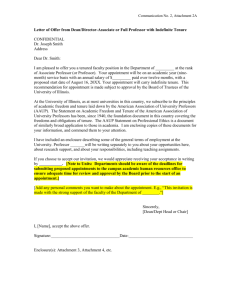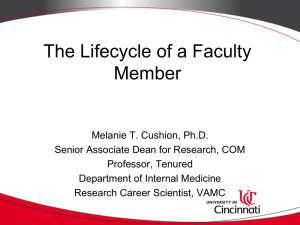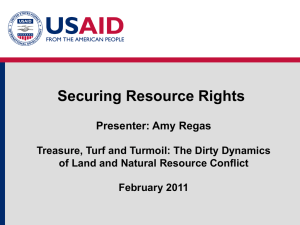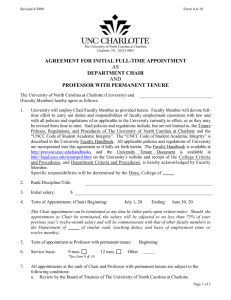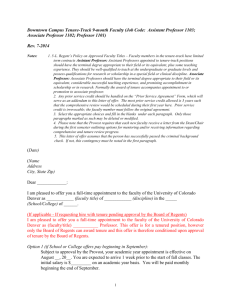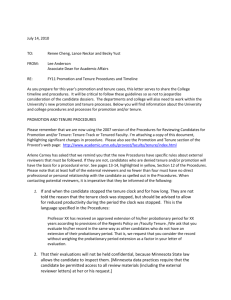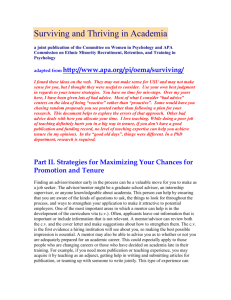Promotion & Tenure Notes
advertisement
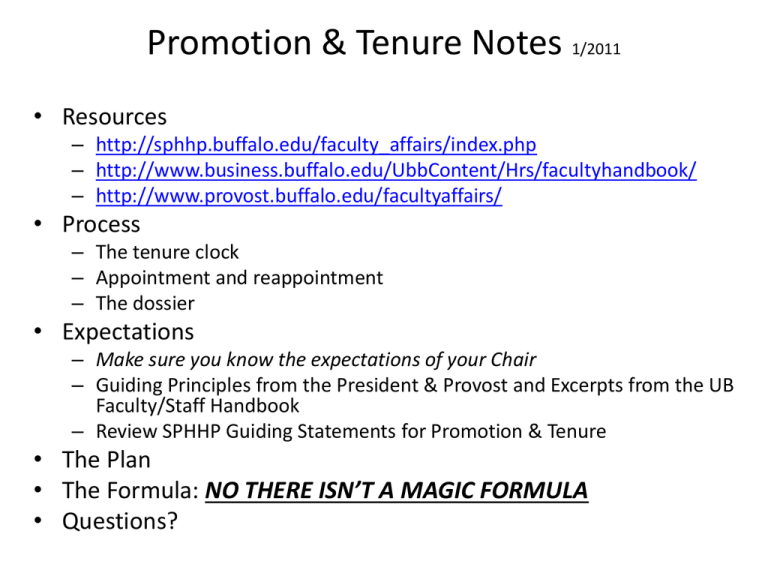
Promotion & Tenure Notes 1/2011 • Resources – http://sphhp.buffalo.edu/faculty_affairs/index.php – http://www.business.buffalo.edu/UbbContent/Hrs/facultyhandbook/ – http://www.provost.buffalo.edu/facultyaffairs/ • Process – The tenure clock – Appointment and reappointment – The dossier • Expectations – Make sure you know the expectations of your Chair – Guiding Principles from the President & Provost and Excerpts from the UB Faculty/Staff Handbook – Review SPHHP Guiding Statements for Promotion & Tenure • The Plan • The Formula: NO THERE ISN’T A MAGIC FORMULA • Questions? Resources • Hardcopy or electronic files: – – – – UB Faculty Staff Handbook SUNY Policies of the Board of Trustees Agreement between UUP & State of New York Promotion and Tenure: Guiding Principles (Statement from President & Provost) – SPHHP Guiding Statements for Promotion and Tenure. • People: – UB Vice Provost for Faculty Affairs: Lucinda Finley – SPHHP Assoc. Dean for Faculty Affairs: Scott White & Administrative Assistant: SPHHP Barbara Putzig <Putzig@buffalo.edu> Process: The Tenure Clock Dossier & External Review in Fall ‘15 through Spring ‘16 If start is 09/01/2010 Mid SPHHP review ~ 09/2013 Termination date is 08/31/2017 Termination letter/notice: 08/31/2017 You have 7 years total. The review starts in your 6th year. You can not extend your clock, only stop it with justification. Consider: Start up time, pilot data, publication lag, grant reviews (2 and out). Process: Appointment and reappointment • You are an unqualified (tenure-track), term appointment (refer to article 30 of UUP contract) – Tenure-track with renewable terms the last of which terminates at the conclusion of your 7th year. – Terms can be 1, 2 or 3 years at the Dean and Chair’s discretion. • Non-renewal (UUP articles 32 and 33) – Things are not working out – Continuing appointment (tenure) is denied (Article 33) Process: Dossier • You: – Curriculum Vitae (complete and accurate) – Statements: Research, Teaching, Service (clear, exciting and interesting; explain discrepancies; sell yourself) – Teaching portfolio • Chair: External Reviewers and Internal Reviewers (4-6/2-3) – Department vote and Chair’s letter • School Promotion and Tenure Committee – SPHHP P&T vote; Chairs’ vote and Dean’s letter • UB Presidents Review Board and PRB Chair’s letter • Provost’s review and Provost’s recommendation letter to the President. • President’s review, and his/her letter with decision sent to SUNY Chancellor –last chance dossier review in President’s office. Expectations: Faculty/Staff Handbook III. University at Buffalo Academic Policies • A major responsibility for establishing and maintaining a high degree of excellence rests on the department chairs, who must recruit individuals of great promise, ensure that faculty will be regularly evaluated, and oversee efforts to assist current faculty members in improving their performance. • Faculty members should be regularly evaluated in three areas: teaching, research or creative activity and service. Expectations: Faculty/Staff Handbook III. University at Buffalo Academic Policies • The basic consideration in assessing the performance of professorial faculty are mastery of subject matter, effectiveness in teaching, scholarly accomplishment, effectiveness of university service, and potential for continuing professional growth. • The evaluation of the candidate’s work should be supported by substantial evidence of peer review … appropriate to the discipline. The candidate must demonstrate solid professional achievement and the potential to meet requirements for the rank of full professor. Clear and convincing evidence must be submitted to show that each candidate has credentials to achieve continuing appointment as an Associate Professor in his or her discipline at the leading public research universities. Expectations: Faculty/Staff Handbook III. University at Buffalo Academic Policies • The importance, value and quality of the candidate’s research or creative activity, and the promise of continuing first-rank performance in this area, are primary considerations. • One of the most important factors in distinguishing university faculty from faculty at other levels of higher education is the continual willingness to place one’s ideas and works before peers for their critical judgment. The Plan 1. Make sure you are properly mentored and that you are receiving annual, timely reviews of your progress in terms of scholarship, teaching and service – Chair – Annual reviews, Department P&T committee or other. – Mentoring committee 2. At the end of 5 years, be able to present clear and convincing evidence of solid professional achievement. – Establish a record of scholarly achievement that reflects a trajectory (“promise to continue to achieve”) that will lead to promotion to full professor. • • • Peer reviewed publication in quality journals Peer reviewed grants Support of peers in your discipline. – You cannot be a bad teacher. If you have difficulty as a teacher in the beginning there are support structures to help you get better. – Meet the SPHHP’s expectations for service Trajectory Research [ a(x + x΄) + b(y + y΄) + z ] + σn + m = tenure Who Knows Tenure Model History Assist. Prof. Assoc. Prof. Prof.
